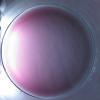
C60 experiments @ home
#691
Posted 10 June 2012 - 11:50 PM
#692
Posted 11 June 2012 - 01:10 AM
#693
Posted 11 June 2012 - 01:15 AM
Wow Allen, that stuff looks good enough to drink! If I was to brew up a magic potion, and it ended up looking rich and dark and red like the blood of 1001 virgins, I'm pretty sure it would make me feel like superman if I drank it. It just strikes me as the kind of thing that's extremely placebogenic. Thus I find it interesting that, by and large, no one is feeling anything from it, with the exception of Turnbuckle. And this is not to say that I think what Turnbuckle reports is placebo. It strikes me as something that could be real, and I take him at his word.
Well, everyone's still alive, right? And maybe there's a movie in it, like Lorenzo's Oil.
#694
Posted 11 June 2012 - 02:10 AM
I don't think that the red color has anything to do with exposure to air.
You are correct. This colour developed in Cataldo' studies even when the oil was in an inert atmosphere.
#695
Posted 11 June 2012 - 04:49 AM
I prepared a new sample of Pompeian Organic EVOO by first vacuum filtering to remove as much O2 as possible, then magnetically stirring with .5g/L C60 in a covered jar without air or light.
Turnbuckle... If you have a moment, could you summarize your current thoughts about optimal dosing, both at the beginning and, perhaps, as a continuing regimen?
#696
Posted 11 June 2012 - 05:59 AM
#697
Posted 11 June 2012 - 12:04 PM
Turnbuckle... If you have a moment, could you summarize your current thoughts about optimal dosing, both at the beginning and, perhaps, as a continuing regimen?
I would take 1-10 mg for a week (for myself, 2.5 seems good enough). Then a long break before taking it again. I would also take PQQ [see note below] and coq-10 and alcar--which I've taken for more than a year--as a regular regime.
This dosing suggestion is partly from my limited experience and partly from my speculative theory on how it works. But even if my theory is wrong, the rats didn't take it continuously either. Not for more than a week.
As for results, keep in mind that the rats didn't report feeling better or running farther or any of those things. They weren't tested for that. Mice in another paper showed hair growth, so you might want to look for that. I noticed it. I also noticed better skin, as did my wife, who took 2.5-10 mg for a few days. I can't say if topical might be better than oral.
The stuff I took initially was shaken in a bottle and unfiltered. It was brown, whiskey colored. The rats took a purple oil, filtered and centrifuged. So all this effort in getting it to look good may make no difference at all. Still, I now have all the equipment and a batch of beautiful magenta oil in the refrigerator. The whiskey stuff I may give to the dogs if they need it.
So take this stuff if you want, but you may not see any effects unless you're as old as I am and have been poisoned by the pharmaceutical industry, especially not any dramatic, same-day effects. If you're young and healthy you might even see negative effects, so please report those too.
--------------------------------------
Taking PQQ may not be wise if you have asthma.
Edited by Turnbuckle, 11 June 2012 - 12:38 PM.
#698
Posted 11 June 2012 - 02:12 PM
Maybe it's my imagination, but skin does seem to be improving... Pores seem smaller.
A
#699
Posted 11 June 2012 - 02:21 PM
Anyone who's trying it topically has a chance to do a controlled experiment: Just put it on one side of your body, but not the other. I always do this with new topicals. If I can't see any difference after a few months, it doesn't make the grade. Because of the mechanism of hair greying, there is reason to believe that C60 could slow or stop that process. It may or may not be possible to reverse it entirely.
#700
Posted 11 June 2012 - 02:23 PM
130mg is being fed to the human rat hybrid... Daily for the last 3 days, and using it on the face topically 2x daily.
Maybe it's my imagination, but skin does seem to be improving... Pores seem smaller.
Just to be certain we understand, Anthony... Do you mean enough Olive OIl to yield a 130mg dose of C60 daily?
#701
Posted 11 June 2012 - 02:48 PM
...Because of the mechanism of hair greying, there is reason to believe that C60 could slow or stop that process. It may or may not be possible to reverse it entirely.
For me it hasn't done anything. For one of my dogs, her gray muzzle is less gray than it was six weeks ago by half.
Edited by Turnbuckle, 11 June 2012 - 03:08 PM.
#702
Posted 11 June 2012 - 02:58 PM
Great Idea.. will probably start doing "Half Face" Application for a bit.
wccaguy,
yes... C60 was dissolved at 0.8 gram per liter...
and the olive oil used daily is approx 4/5 of a cup.. which is approx 189ml
This should provide around 130mg of C60 in the 189ml Olive Oil solution..
Uhmm...ok I just redid the calculation, and I maybe using a little more than 130mg... maybe closer to 150mg if it all dissolved properly.
The face application was just dipping of fingers in the oil a bit and rubbing it in the skin of the face. Once in the morning, and once at night.
Cheers
A
Edited by Anthony_Loera, 11 June 2012 - 03:02 PM.
#703
Posted 11 June 2012 - 04:45 PM
#704
Posted 11 June 2012 - 06:14 PM
Daily for the last 3 days, and using it on the face topically 2x daily.
Make sure you keep it well away from your eyes. Most fullerene adducts seem to produce reactive oxygen species on exposure to light,and at least one study indicates corneal damage as a result.
Same goes for topical administration - prob best to mix some of the oil into a sunscreen,or apply it at night.
#705
Posted 11 June 2012 - 06:27 PM
The safety of highly purified fullerenes (HPFs) for utilization as antioxidants in the cosmetic industry was evaluated by studying the toxicity and effects on laboratory animals, human epidermal keratinocytes, and human fibroblasts. The HPFs did not induce primary or cumulative skin irritation, skin sensitization, skin photosensitization or contact phototoxicity. No skin reaction was observed in the patch test on human skin. In the primary eye-irritation test on rabbits, conjunctival redness and corneal epithelial defects were observed in all animals of the eye-unwashed group at 1 and 24 hr after application, but disappeared by 48 hr after application. The irritation may have been caused by administration of insoluble fullerene powder.
Source: http://www.ncbi.nlm....amage fullerene
#706
Posted 11 June 2012 - 06:50 PM
http://www.ncbi.nlm....les/PMC2358981/
Maybe users of fullerene should all dress like Italians, and wear sunglasses?
#707
Posted 11 June 2012 - 06:57 PM
If anybody is trying to match the rat dosage with an allometric scaling adjustment (rather than a straight linear updosing for higher mass), it is more like 0.5mg per kg to match the rats.Anthony's report of 130mg is about what Baati's rats got, adjusting for mass.
Anyone who's trying it topically has a chance to do a controlled experiment: Just put it on one side of your body, but not the other. I always do this with new topicals. If I can't see any difference after a few months, it doesn't make the grade. Because of the mechanism of hair greying, there is reason to believe that C60 could slow or stop that process. It may or may not be possible to reverse it entirely.
#708
Posted 11 June 2012 - 07:23 PM
If anybody is trying to match the rat dosage with an allometric scaling adjustment (rather than a straight linear updosing for higher mass), it is more like 0.5mg per kg to match the rats.
One thing, though, is that we don't know if there is a dose response curve and if so where on that curve the experimental protocol lies. So it could be that much more would extend the lives indefinitely, or much less would still have the doubling effect.
#709
Posted 11 June 2012 - 07:24 PM
Exposure to either UVA or visible light in the presence of >5 µM fullerol induced phototoxic damage. When cells were pretreated with non-toxic antioxidants: 20 µM lutein, 1 mM N-acetyl cysteine, or 1 mM L-ascorbic acid prior to irradiation, only the singlet oxygen quencher lutein significantly protected against fullerol photodamage. Apoptosis was observed in lens cells treated with fullerol whether or not the cells were irradiated, in the order UVA > visible light > dark. Dynamic light scattering (DLS) showed that in the presence of the endogenous lens protein α-crystallin, large aggregates of fullerol were reduced. In conclusion, fullerol is both cytotoxic and phototoxic to human lens epithelial cells. Although the acute toxicity of water soluble nano-C60(OH)22–26 is low, these compounds are retained in the body for long periods, raising concern for their chronic toxic effect. Before fullerols are used to deliver drugs to the eye, they should be tested for photo- and cytotoxicityin vivo.
Maybe users of fullerene should all dress like Italians, and wear sunglasses?
Well, That was an in vitro study where cells were soaked in high concentrations of polyhydroxy fullerene and irradiated. I think it's fair to say that we should keep fullerenes out of our eyes, just on general principles, but there are already a number of topicals on the market that claim to contain fullerenes. And again, not all fullerenes are identical. This paper was about a polyhydroxy version, while ours probably have no or very little hydroxy substitution.
#710
Posted 11 June 2012 - 07:25 PM
Exposure to either UVA or visible light in the presence of >5 µM fullerol induced phototoxic damage. When cells were pretreated with non-toxic antioxidants: 20 µM lutein, 1 mM N-acetyl cysteine, or 1 mM L-ascorbic acid prior to irradiation, only the singlet oxygen quencher lutein significantly protected against fullerol photodamage. Apoptosis was observed in lens cells treated with fullerol whether or not the cells were irradiated, in the order UVA > visible light > dark. Dynamic light scattering (DLS) showed that in the presence of the endogenous lens protein α-crystallin, large aggregates of fullerol were reduced. In conclusion, fullerol is both cytotoxic and phototoxic to human lens epithelial cells. Although the acute toxicity of water soluble nano-C60(OH)22–26 is low, these compounds are retained in the body for long periods, raising concern for their chronic toxic effect. Before fullerols are used to deliver drugs to the eye, they should be tested for photo- and cytotoxicityin vivo.
http://www.ncbi.nlm....les/PMC2358981/
Maybe users of fullerene should all dress like Italians, and wear sunglasses?
Fullerol--produced by hydrolysis of C60Br24, according to the manufacturer--isn't anything like what we're dealing with here.
#711
Posted 11 June 2012 - 08:31 PM
That being said , it is pretty well established that a wide range of fullerene adducts produce reactive oxygen species on photoexcitation.
Photoexcited fullerenes are a whole different kettle of fish.
We have no reason to assume that the fullerene adducts produced in olive oil will behave any differently when photoexcited.
So, accumulation of fullerene adducts in the eye tissue, if it occurs, is a reason for exercising caution at this early stage, for early adopters..
Bioaccumulation in the lens and corneal and other eye tissue, if it occurs, may take place gradually. Or it may happen quickly. we don't know. it may not happen at all.
If it does bioaccumulate in eye tissue, the ROS formed may not be sufficient to cause damage. Or it may be sufficient to cause damage.
Personally, as there is an element of easily avoidable risk, I would advise dark glasses during the day,( not a bad habit anyway for someone planning to live a long time who wants healthy eyes) and only topical application during non daylight hours, or application with sunscreen.
http://141.105.33.55...s(2004)(24).pdf
http://www.sciencedi...300483X00002778
http://www.springerl...27318058188331/
http://books.google....PA129&lpg=PA129 Chapter six
http://exp-oncology....377.pdf?upload=
Diagram of the chemical process here:
http://www.loc.ethz....grpYamakoshi_EN
Edited by Metrodorus, 11 June 2012 - 09:26 PM.
#712
Posted 11 June 2012 - 09:11 PM
thank you for that feedbackThere's been some misunderstanding in this thread about what exactly a hydrogen bond is. Classic hydrogen bonds only occur when there is a hydrogen covalently attached to an electronegative element like oxygen or nitrogen. The electrons in this bond are attracted to the more electronegative element, resulting in a partial positive charge on the hydrogen and a partial negative charge on the oxygen or nitrogen. Thus you have a small electrostatic dipole. This dipole can interact electrostatically with others like itself, as such:
O-H - - - - O-H
In this example, the dashed line is the hydrogen bond, and the other bonds are normal covalent bonds. Here's the important thing: The energy needed to break a hydrogen bond is low; between 5-30kj/m. The energy needed to break a covalent bond is large, like 350kj/m for a carbon-carbon single bond.
Hydrogen bonds are stronger than Van der Waals interactions, but covalent bonds are one to two orders of magnitude stronger.
Pristine C60 has no electronegative atoms, thus can not engage in hydrogen bonds as they're normally defined.
#713
Posted 11 June 2012 - 10:35 PM
#714
Posted 11 June 2012 - 10:53 PM
#715
Posted 11 June 2012 - 11:04 PM
#716
Posted 12 June 2012 - 02:49 AM
+1thank you for that feedback
#717
Posted 12 June 2012 - 05:46 AM
#718
Posted 12 June 2012 - 12:44 PM
#719
Posted 12 June 2012 - 04:24 PM
 IMG_20120612_121804.jpg 46.46KB
10 downloads
IMG_20120612_121804.jpg 46.46KB
10 downloads
#720
Posted 12 June 2012 - 04:34 PM
http://science.slash...hange-as-we-age
one link
http://news.sciencem...nes.html?ref=hp
says:
"Recent research suggests that changes in DNA methylation patterns as a person gets older may contribute to human diseases for which risk increases with age, including cancer. To get a better idea of how methylation patterns change with age, a team led by Manel Esteller, an epigenetics researcher at the Bellvitge Biomedical Research Institute in Barcelona, Spain, looked at two extreme cases: A newborn male baby and a man aged 103 years.
The team extracted DNA from white blood cells taken from the blood of the elderly man and from the umbilical cord blood of the baby and determined its methylation pattern using a fairly new technique called whole-genome bisulfite sequencing (WGBS). With WGBS, DNA is exposed to the chemical sodium bisulfite, which has no effect on cytosines with methyl groups bound to them but turns nonmethylated cytosines into another nucleotide called uracil. The result is an epigenetic map (see illustration) that shows exactly which DNA sites are methylated and which are not.
As the team reports online today in the Proceedings of the National Academy of Sciences, it found a significantly higher amount of cytosine methylation in the newborn than in the centenarian: 80.5% of all cytosine nucleotides, compared with 73%. To look at an intermediate case, the team also performed WGBS on the DNA of a 26-year-old male subject; the methylation level was also intermediate, about 78%."
This suggests that if C60 were to remove our DNA methylation, that would not be a good thing.
Also tagged with one or more of these keywords: buckyball, c60, fullerene, buckyballs
7 user(s) are reading this topic
0 members, 7 guests, 0 anonymous users




















































